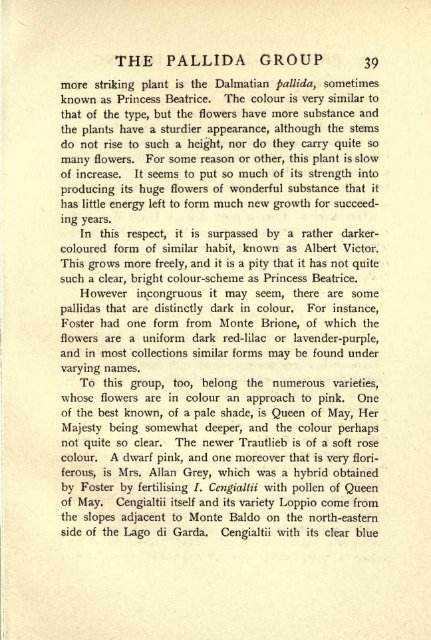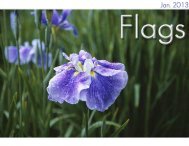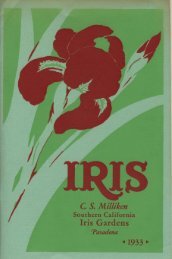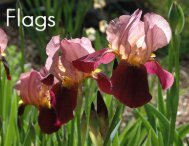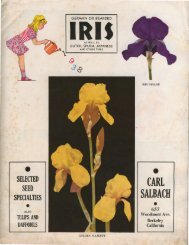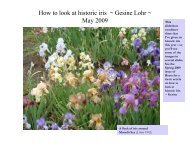Irises - Historic Iris Preservation Society
Irises - Historic Iris Preservation Society
Irises - Historic Iris Preservation Society
Create successful ePaper yourself
Turn your PDF publications into a flip-book with our unique Google optimized e-Paper software.
THE PALLIDA GROUP 39<br />
more striking plant<br />
is the Dalmatian pallida, sometimes<br />
known as Princess Beatrice. The colour is<br />
very similar to<br />
that of the type, but the flowers have more substance and<br />
the plants have a sturdier appearance, although the stems<br />
do not rise to such a height, nor do they carry quite so<br />
many flowers. For some reason or other, this plant is slow<br />
of increase. It seems to put so much of its strength into<br />
producing its huge flowers of wonderful substance that it<br />
has little<br />
energy left to form much new growth for succeeding<br />
years.<br />
In this respect,<br />
it is<br />
surpassed by<br />
a rather darkercoloured<br />
form of similar habit, known as Albert Victor.<br />
This grows more freely, and it is a pity that it has not quite<br />
such a clear, bright colour-scheme as Princess Beatrice.<br />
However incongruous<br />
it<br />
may seem, there are some<br />
pallidas that are distinctly dark in colour. For instance,<br />
Foster had one form from Monte Brione, of which the<br />
flowers are a uniform dark red-lilac or lavender-purple,<br />
and in most collections similar forms may be found under<br />
varying names.<br />
To this group, too, belong the numerous varieties,<br />
whose flowers are in colour an approach to pink. One<br />
of the best known, of a pale shade, is Queen of May, Her<br />
Majesty being somewhat deeper, and the colour perhaps<br />
not quite so clear. The newer Trautlieb is of a soft rose<br />
colour. A dwarf pink, and one moreover that is<br />
very floriferous,<br />
is Mrs. Allan Grey, which was a hybrid obtained<br />
by Foster by fertilising 7. Cengialtii with pollen of Queen<br />
of May. Cengialtii itself and its variety Loppio come from<br />
the slopes adjacent to Monte Baldo on the north-eastern<br />
side of the Lago di Garda. Cengialtii with its clear blue


